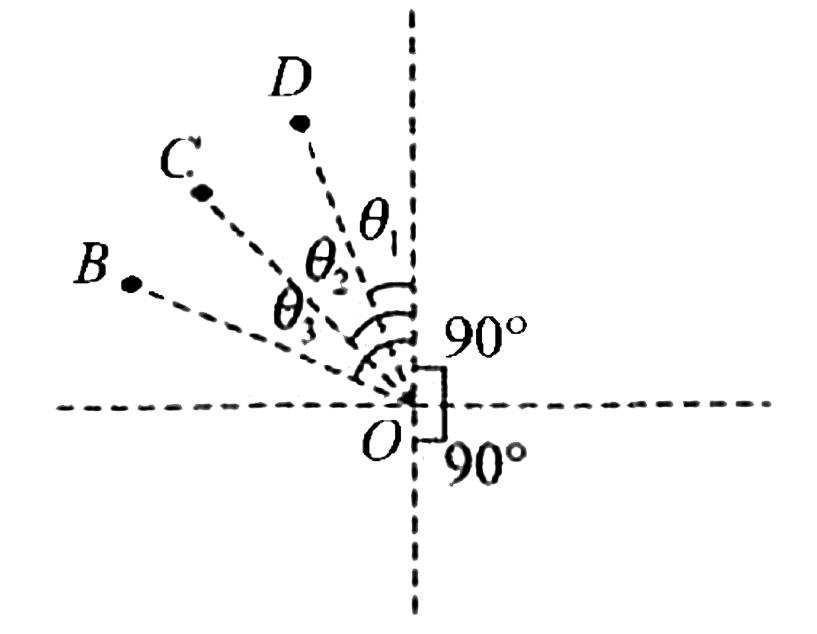For scattering by an .inverse square. field (such as that produced by a charged nucleus in Rutherford.s model), the relation between impact parameter b and the scattering angle θ is given by,
b=Ze2cotθ/24πε0(12mv2)
For a given energy of the projectile, does the scattering angle increase or decrease with dec rease in impact parameter ?
To solve the problem, we need to analyze the relationship between the impact parameter b and the scattering angle θ as given by the equation:
b=Ze2cot(θ/2)4πϵ0(12mv2)
1. Understand the Variables:
- b is the impact parameter.
- θ is the scattering angle.
- Z is the atomic number (charge of the nucleus).
- e is the charge of the electron.
- ϵ0 is the permittivity of free space.
- m is the mass of the projectile.
- v is the velocity of the projectile.
2. Analyze the Equation:
- The equation shows that the impact parameter b is directly related to cot(θ/2).
- As b decreases, we need to see how cot(θ/2) behaves.
3. Relate b and θ:
- Since b is directly proportional to cot(θ/2), if b decreases, then cot(θ/2) must also decrease.
- The cotangent function decreases as the angle increases. Therefore, if cot(θ/2) decreases, θ/2 must increase.
4. Conclude on θ:
- If θ/2 increases, then θ itself must also increase (since θ=2(θ/2)).
- Thus, as the impact parameter b decreases, the scattering angle θ increases.
Final Answer:
As the impact parameter b decreases, the scattering angle θ increases.
---
- b is the impact parameter.
- θ is the scattering angle.
- Z is the atomic number (charge of the nucleus).
- e is the charge of the electron.
- ϵ0 is the permittivity of free space.
- m is the mass of the projectile.
- v is the velocity of the projectile.
- The equation shows that the impact parameter b is directly related to cot(θ/2).
- As b decreases, we need to see how cot(θ/2) behaves.
- Since b is directly proportional to cot(θ/2), if b decreases, then cot(θ/2) must also decrease.
- The cotangent function decreases as the angle increases. Therefore, if cot(θ/2) decreases, θ/2 must increase.
- If θ/2 increases, then θ itself must also increase (since θ=2(θ/2)).
- Thus, as the impact parameter b decreases, the scattering angle θ increases.
As the impact parameter b decreases, the scattering angle θ increases.
Topper's Solved these Questions
- ATOMSBOOK - AAKASH SERIESCHAPTER - ATOMSEXERCISE - EXERCISE - I
20 Videos
- ATOMSBOOK - AAKASH SERIESCHAPTER - ATOMSEXERCISE - EXERCISE - II
19 Videos
- ATOMSBOOK - AAKASH SERIESCHAPTER - ATOMSEXERCISE - EXERCISE -III
25 Videos
- APPENDICES (REVISION EXERCISE)BOOK - AAKASH SERIESCHAPTER - APPENDICES (REVISION EXERCISE)EXERCISE - LAW OF MOTION
128 Videos
- CAPACITORS BOOK - AAKASH SERIESCHAPTER - CAPACITORS EXERCISE - PRACTICE SHEET (ADVANCED) (Integer Type Questions)
2 Videos
Similar Questions
For scattering by an inverse square field (such as that produced by a charged nucleus in Rutherford's model), the relation between impact parameter b and the scattering angle θ is given by,
b=Ze2cotθ/24πε0(12mv2)
What is the impact parameter at which the scattering angle is 90∘ for Z = 79 and initial energy equal to 10MeV ?
View SolutionIn Rutherford scattering experiment, wha will be the ratio of impact parameter for scattering angles θ1=90∘andθ2=120∘
View Solution
Knowledge Check
For scattering by an inverse-square field (such as that produced by a charged nucleus in Rutherford's model) the relation between impact parameter b and the scattering angle θ is given by, the scattering angle for b=0 is
A180∘B90∘C45∘D120∘
In Rutherford scattering experiment, what will be the correct angle for α scattering for an impact parameter b=0 ?
View SolutionIn Rutherford scattering experiment, what will b ethe correct angle for α scattering for an impact parameter b=0 ?
View SolutionIn a Rutherford scattering experiment when a projectile of charge Z1 and mass M1 approaches s target nucleus of charge Z2 and mass M2, te distance of closed approach is r0. The energy of the projectile is
View SolutionIn a Rutherford scattering experiment when a projectile of change Z1 and mass M1 approaches s target nucleus of change Z2 and mass M2, te distance of closed approach is r0. The energy of the projectile is
View SolutionThree particles, each having a charge of 10μC are placed at the coners of an equilateral triangle of side 10cm. The electrostatic potential energy of the system is (Given 14πε0=9×109N−m2/C2)
View SolutionFour similar (+q) are placed at origin O, B, C and D as shown. The angles are as shown. Charges at B, C and D are equidistant from O at a distance of a. The forces of repulsion experienced by charge at O due to charges at B and D along CO are equal, given by q2√38πε0a2. Find the relation between θ1,θ2 and θ3:

View SolutionThe position of a projectile launched from the origin at t = 0 is given by s=(40ˆi+50ˆj)mat t=2s. if the projectile was launched at an angle θ from the horizontal, then θis (take g = 10 ms–2
View Solution
